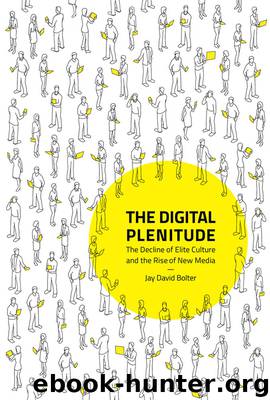The Digital Plenitude by Jay David Bolter;

Author:Jay David Bolter;
Language: eng
Format: epub
Tags: cultural history; digital media; elite culture; modernism; social media; video games; cultural communities; John Lennon; Marshall McLuhan; Steve Jobs; contemporary media; catharsis; flow; simulation; remix; film; television; hip-hop; Jay Z; intellectual property; digitization; procedurality; mechanization; identity politics; Trump
Publisher: MIT Press
Figure 5.1
YouTube’s interface encourages flow.
Like other microblogging sites, Twitter offers each user a personalized stream of short messages from all the posters that the user has chosen to follow—including personal friends, celebrities, news organizations, companies, and nonprofits. If she follows enough sources, her stream of messages will change as fast as she can refresh her screen. As with YouTube, but far more easily, she can contribute to the conversation by “retweeting” the messages of others or writing her own. The resulting stream is an unpredictable combination of public and private communication. Twitter interleaves the messages from all the sources so that there is no coherence between consecutive messages and no need for the process ever to end. Those trained in traditional rhetorical practices may find the individual tweets and the whole stream almost meaningless. But for Twitter regulars, the rhythm of short texts is satisfying in its own right.
Multimedia microblogs such as Instagram, Tumblr, and Snapchat privilege images and audio, and each platform offers a subtly different version of flow. Snapchat enforces a staccato rhythm by making its photo messages, “snaps,” necessarily ephemeral. The stated purpose is to encourage playfulness among senders and recipients and to counteract the tendency to treat social media services as a permanent record of your online identity. It might seem that Snapchat enables you to lose yourself in the moment without having to regret the next day the selfie that you took in that moment, but it is possible for the recipient to make and save a screenshot. You may lose yourself in the social media plenitude, but others can almost always find you.
Social media such as Facebook and YouTube are often said to be exercises in online identity construction (Boyd 2014). We will discuss that aspect of social media in chapter 8. For now we will just take note of the fact that social media as flow experiences are therapeutic, helping an individual to negotiate her relationship to her social world. Csikszentmihalyi (1991) himself ascribed a therapeutic value to flow experiences. He suggested that in a secular and often hostile world, flow gives individuals a feeling of control in their own smaller domains (games, hobbies, work activities). Flow becomes “the process of achieving happiness through control over one’s inner life” (6). Csikszentmihalyi’s flow culture is one in which individuals aim at nothing higher than personal satisfaction. The psychology of flow does not encourage them to think of themselves as actors in a larger social or political drama. At least from 1800 to the end of the twentieth century, politically aware citizens were encouraged to see their own history as marked by the same dramatic curve as that of their state or nation. Flow culture does not endorse such a view. Instead, the identity constructed on Facebook and YouTube is static or homeostatic: its modest goal is to keep itself within bounds, within the channels provided by a Facebook page.
Our Time Traveler
Much about flow culture would mystify our time traveler from 1960, but not because flow experiences were unknown in her time.
Download
This site does not store any files on its server. We only index and link to content provided by other sites. Please contact the content providers to delete copyright contents if any and email us, we'll remove relevant links or contents immediately.
Cecilia; Or, Memoirs of an Heiress — Volume 1 by Fanny Burney(32434)
Cecilia; Or, Memoirs of an Heiress — Volume 2 by Fanny Burney(31871)
Cecilia; Or, Memoirs of an Heiress — Volume 3 by Fanny Burney(31854)
The Great Music City by Andrea Baker(31349)
We're Going to Need More Wine by Gabrielle Union(18967)
All the Missing Girls by Megan Miranda(15570)
Pimp by Iceberg Slim(14393)
Bombshells: Glamour Girls of a Lifetime by Sullivan Steve(13972)
Talking to Strangers by Malcolm Gladwell(13222)
Norse Mythology by Gaiman Neil(13204)
Fifty Shades Freed by E L James(13157)
For the Love of Europe by Rick Steves(12983)
Mindhunter: Inside the FBI's Elite Serial Crime Unit by John E. Douglas & Mark Olshaker(9200)
Crazy Rich Asians by Kevin Kwan(9167)
The Lost Art of Listening by Michael P. Nichols(7406)
Enlightenment Now: The Case for Reason, Science, Humanism, and Progress by Steven Pinker(7231)
The Four Agreements by Don Miguel Ruiz(6630)
Bad Blood by John Carreyrou(6552)
Weapons of Math Destruction by Cathy O'Neil(6143)
